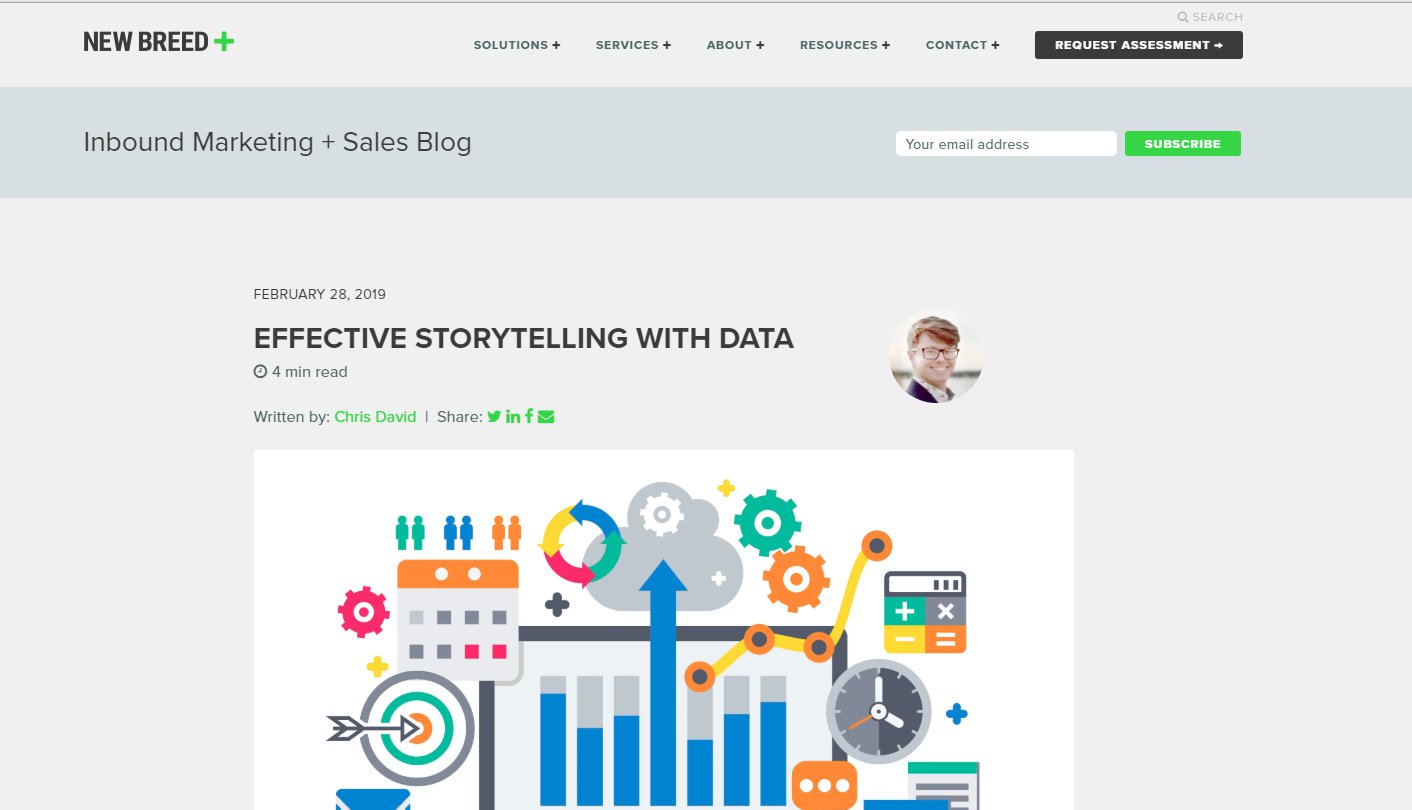Written as a guest blog for New Breed – Learn More
Effective data analysis is the single most important factor in every marketing strategy. Data can enrich a hypothesis, validate outcomes and optimize performance. The data analytics industry is booming, and companies are pumping out new reporting dashboards with every metric imaginable every day. Although these reports are easy to generate, it can still be a challenge to interpret and present the data in meaningful and action-oriented ways.
Along with data analytics, storytelling has become an equally popular term in the marketing world. Storytelling is an inherent part of who we are, and it is a unique and valuable skill found in successful business professionals. Data delivered as a story, in a thematic approach, may bridge the interpretation and communication gap of analyst and audience.
How to Interpret and Present Data to Tell Meaningful Stories to Your Client or Boss
Asking Questions
Data analytics portals can be a trove of exciting and time-consuming reports. Document your goals and questions before opening reports to avoid a long trip down the rabbit hole. Your questions should be quantitative and performance-focused.
- How is the marketing strategy improving the quantity and quality of traffic that is engaging with the brand?
- What metrics are key performance indicators of your marketing strategy?
- What can be done to optimize the campaign and improve the marketing strategy?
Document these questions prior to diving into your data dashboards to stay focused and to streamline your reporting efforts. Keep detailed notes to reference in elements of your storyboard.
Elements of Your Story
Every story has basic elements. Here’s how they parallel with marketing strategies:
Preface
What has been completed on the account up to this point? What should your audience expect throughout the presentation? What will your audience learn by the end of the story?
Characters and Setting
Your marketing content is the setting of your story. Without content, there is no buyer’s journey or plot. The characters of your story are the website users and buyer personas.
Plot AKA Buyer’s Journey
The plot is the journey from acquisition through conversion — in that order. How do users discover the brand, and what actions did they take to complete a conversion?
Conflict and Resolution
Without conflict, there is no opportunity for improvement. It’s the job of the data analyst to identify this conflict, so you may improve the marketing strategy. Conflict comes in all shapes and sizes, and it doesn’t necessarily have to be bad news. You should always be pushing the envelope to uncover possibilities to improve performance.
Use these elements to organize your data points into a meaningful storyboard when presenting your reports. You should be able to explain how customers are finding the website, who the customers are, why they are engaging and what can be done to improve and optimize efforts.
The Analyst’s Storyline
Data analysts should start out with the big picture, then zoom in to focus on specific metrics and develop a data-driven action plan.
1. Visibility Metrics:
These metrics are the broadest of all metrics but less important than behavior and conversion, which is why they should be reviewed first. They include Impressions, Clicks, and Page Rank, for both Organic and Paid.
Impression and click metrics identify how many users are seeing the links versus how many are clicking on them. Page rank is an indicator of many things, including domain authority, content quality, user engagement, and how well an ad or SERP listing is written or designed. Page rank is one of the broadest KPI’s for your entire marketing strategy. Therefore, it should be examined first.
2. Acquisition Metrics:
These metrics include users, new users and sessions.
These metrics are a broad indicator of where new and repeat website traffic is coming from. Acquisition metrics let us know the quantity of traffic, but they don’t explain the quality of traffic.
3. Behavior and Engagement Metrics:
These metrics include bounce Rate, pages per session and average session duration.
Just as acquisition metrics measure the quantity of website traffic, behavior metrics measure the quality of traffic. For example, the bounce rate will let us know if the page content is meeting user expectations. Did the content solve the user’s problems? Has the ad/link targeted the right audience? Pages per session and session duration is an indicator of content quality, sitemap organization, and relevancy for a specific target audience.
4. Conversion Metrics:
These metrics include conversion Rate, goal completions, goal value, lifetime goal value and, if you use HubSpot, lead scoring.
What is the value of each marketing channel? Why are people converting/not converting? What are the conversion indicators? Which pages contribute best to conversion, and how can we replicate this success in other areas of the marketing campaign?
5. The Action Plan:
The conclusion to your story should include an action plan, which should be explained through your presentation. Segueing into the action plan will be a natural ending to the presentation since it will inform your audience of your next steps and their importance. This is also a good opportunity to get buy-in on a new strategy or to expand the current efforts on an account.
Protips:
- Build a story with a centralized theme, which explains your marketing strategy as a holistic effort with a deeply connected purpose.
- Less is more. Cherry-pick the most relevant highlights and package them for an efficient review.
- Be honest! Your client or boss will appreciate your unbiased transparency, and they will respect your attention to detail. If you present unfavorable data, make sure it’s coupled with an action plan for improvement.
- Prepare a presentation with documented visuals, which can be shared and referenced at a later date if needed. This tangible asset might take one extra step, but it will bring value to your account, especially if you can deliver these reports as a short video.
- Display concepts individually to keep the focus on one topic at a time. Displaying too many metrics can cause “data overload,” and overload can distract from your intended pathways.
The Takeaway
The reports used to present analytics can be difficult to interpret and effectively explain, making the construction of a data-oriented action plan a somewhat labor-intensive task. Follow the model described in this article to stay focused on your goals. Keep your storyline unified and your audience engaged. Although there is no one-size-fits-all solution, you’ll become more comfortable with data and storytelling as patience and practice improve.





